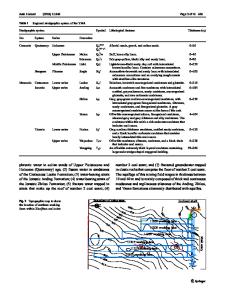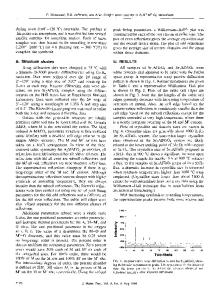Differences in evaporite geochemistry of the greater Ordos Ordovician salt basin, China: evidence from the M 5 6 submemb
- PDF / 7,258,098 Bytes
- 15 Pages / 595.276 x 790.866 pts Page_size
- 45 Downloads / 320 Views
ORIGINAL ARTICLE
Differences in evaporite geochemistry of the greater Ordos Ordovician salt basin, China: evidence from the M56 submember of the Majiagou Formation Fu Fan1 · Fan‑Wei Meng2 · Yong‑Sheng Zhang1 · Mian‑Ping Zheng1 · Kui Su1 · En‑Yuan Xing1 Accepted: 7 September 2020 © Springer-Verlag GmbH Germany, part of Springer Nature 2020
Abstract Ordovician evaporites are very rare in the global geological record. Thick salt deposits in the Ordovician Majiagou Formation are present in the eastern greater Ordos Basin, China. Potash mineralization layers and a thin industrial grade potash layer occur in the sixth submember of the fifth member of the formation, thus indicating a good potash prospect. The eastern and western salt depressions are separated by an uplift and have been divided into five secondary salt sags (East-1, East-2, West-1, West-2, and West-3). The ratio of the salt layer thickness to that of the whole succession was very low in the West-2 sag and the salt depositional center was the East-2 sag, which implied that seawater entered the basin from the western sags and led to desalination and the formation of deep-water sediments. Analyses indicated that the potash formation conditions were obviously different in the salt sags. Although a thin potash layer was present in the East-1 sag, findings indicated that this area was not favorable for potash accumulation. The geochemical and sedimentary environment of the East-2 sag was similar to that of typical potash basins globally. Rounded sylvine grains occurred between salt crystals. The preservation characteristics indicated that evaporite deposits had reached the KCl bitterns stage. An eastward input of terrestrial materials carried a large amount of clay, and the clay layer protected previously deposited sylvine particles, thereby avoiding further potassium dissolution. Sedimentary, geochemical, and petrological evidences indicate good prospects for potash exploration in the East-2 salt sag. Keywords Ordos basin · Ordovician · M56 submember · Majiagou formation · Sylvine
Introduction Worldwide, salt deposits are very rare in Ordovician rocks (Ronov et al. 1980; Kovalevych et al. 2006; Meng et al. 2018). Apart from the Ordos basin in central China, massive saline deposits of an Ordovician age have only been reported for the Canadian Arctic basin (Zharkov et al. 1984). Electronic supplementary material The online version of this article (https://doi.org/10.1007/s13146-020-00632-2) contains supplementary material, which is available to authorized users. * Fan‑Wei Meng [email protected] 1
Institute of Mineral Resources, Chinese Academy of Geological Sciences, Beijing 100037, China
State Key Laboratory of Paleobiology and Stratigraphy, Nanjing Institute of Geology and Paleontology, Chinese Academy of Sciences, Nanjing 210008, China
2
However, the greater Ordos basin contains massive salt deposits (Li et al. 2011). Potassium–magnesium salt deposits are distributed in the eastern part of the northern Shanxi salt basin, which is located i
Data Loading...











